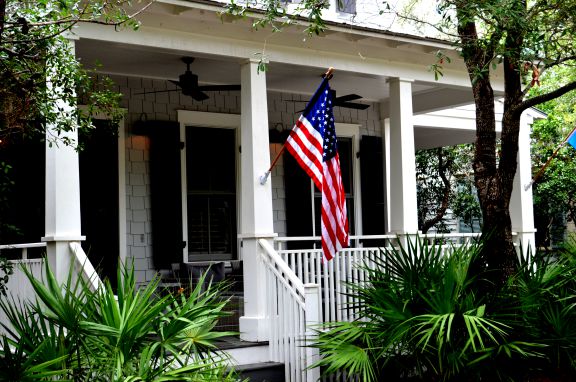
“I was not aware of how much vital energy had gone into this struggle until the struggle was removed.”
—Tennessee Williams
Photo: Deborah Fagan Carpenter


“I was not aware of how much vital energy had gone into this struggle until the struggle was removed.”
—Tennessee Williams
Photo: Deborah Fagan Carpenter
Memorial Day—Did you know?

Leading up to Memorial Day, I’ve seen some interesting articles describing how the holiday began, which prompted me to do a little research. The bottom line, of course, is that Memorial Day, originally called Decoration Day, is a federal holiday in the United States set aside to honor and mourn the military personnel who died during their service in the United States Armed Forces.
The exact origin of the holiday, according to the Encyclopedia Britannica and Wikipedia, is uncertain, but it definitely began during the Civil War when the graves of the fallen were decorated with flowers. The Britannica says that in October 1864, three women in Boalsburg, Pennsylvania, decorated the graves of loved ones who died during the Civil War and then returned in July 1865, joined by many others for a larger tribute.
On May 1, 1865, former slaves in Charleston, South Carolina honored 257 dead Union soldiers who had been buried in a mass grave in a Confederate prison camp, once a race track and jockey club. The former slaves worked for two weeks to give the men a proper burial in gratitude for their having fought for their freedom. A parade led by 3,000 black school children singing “John Brown’s Body,” followed by women carrying baskets of flowers, crosses, and wreaths, and joined by Union Infantry and other black and white citizens commenced after the burial. After the parade there were socail gatherings and picnics — not unlike our current way of honoring the dead on Memorial Day.
In 1866, women in Columbus, Mississippi, a hospital town during the war, held a formal observance for the 620,000 Union and Confederate dead by laying wreaths on whatever graves there were in the town. On May 5, 1868, General John A. Logan, leader of an organization for Northern Civil War veterans, called for a nationwide day of remembrance later that month. In 1966, by congressional proclamation, Waterloo, New York, was cited as the birthplace of Decoration Day because it hosted an annual, community-wide event, during which businesses closed and residents decorated the graves of soldiers with flowers and flags.
After World War I, the day came to be observed to honor those who had died in all U.S. wars, and its name changed from Decoration Day to Memorial Day. Memorial Day continued to be observed on May 30, the date General Logan had selected for the first Decoration Day. But in 1968, Congress passed the Uniform Monday Holiday Act, which established Memorial Day as the last Monday in May in order to create a three-day weekend for federal employees. The change went into effect in 1971. The same law also declared Memorial Day as a federal holiday.
Regardless of its origin or who benefits from the holiday, Memorial Day reminds us that men and women gave their lives, sometimes for reasons they didn’t fully understand, but more often fighting for and protecting the freedoms that we currently experience. It’s much more than just a long weekend and an excuse to have a cook-out, with a casual acknowedgement of some fallen soldiers.
A notable fact that I discovered during my inquiry is that each year on Memorial Day a national moment of remembrance takes place at 3:00 p.m. local time, wherever you are. I never really knew that, or, most of this.
Photos: Deborah Fagan Carpenter
SOUTHERN CONDIMENTS ON THE SOUTHERN SPREAD
Our culture, our history, our spirit, and our hospitality are some of the ingredients. Southern foods are heavily influenced by African, English, Scottish, Irish, French, and Native-American cuisine. Although most of them are served across the country today, there are foods in the U.S. strictly thought of as SOUTHERN. There’s Creole, Lowcountry, and Floribbean, and I’m not sure where fried chicken and deviled eggs fit into the mix, but they perform with a southern accent, to be sure. In “The Southern Spread,” we’re exploring southern foods and traditions.
Nothing incites an argument quicker than a political position, but if you’re just looking for a run-of-the-mill tiff, declare your favorite hot sauce to be the best there is. I don’t have any personal experience with brands from other parts of the country, but serious, even casual food enthusiasts everywhere are pretty opinionated about their preferred condiments. Southerners are dug in.

Hot sauces are definitely at the top of the list of condiments used regularly in the South, and Tabasco is a brand whose name is practically synonymous with the term hot sauce. I’m not really looking for a dispute over which is the best or hottest hot sauce, but it’s the variety I use the most—in a multitude of recipes— mainly, I suppose because it’s what I grew up with. I use it frequently to add some zip to all kinds of fare, not necessarily for the heat. That includes soups and other warm concoctions and cold dishes like dips and deviled eggs.
Tabasco is and always has been bottled on Avery Island in south Louisiana by the McIlhenny family. The original vinegar-based sauce uses the tabasco pepper, which originated in Central America, although the line also includes sauces made with chipotle, jalapeno, and habanero peppers. A trip to Avery Island is a unique day trip into the world of Tabasco that consists of a short lecture and film about the origin and production of the world-famous sauce. Naturally, there’s an opportunity to visit the company store that sells everything from varying sizes of the different Tabasco sauces—including bottles large enough to be statues and small enough to put in your top pocket—pot holders, hats, aprons, and a gazillion other collectibles printed with the recognizable logo.
Crystal Hot Sauce, bottled initially in New Orleans, is Tabasco’s neck ‘n neck competition. It’s also a vinegar-based sauce, but it’s made with cayenne peppers.
Alvin Baumer, the grandson of Dottie Brennan, one of the original proprietors of Commander’s Palace, acquired the recipe for Crystal Hot Sauce when he bought Mill’s Fruit Products, a sno-ball syrup company. It’s one hot sauce that can be found, sometimes alongside Tabasco, on tables of well-respected restaurants all across New Orleans and the Gulf Coast.
Hurricane Katrina destroyed Crystal’s 75-year-old manufacturing facility in New Orleans, at which point the company moved to a new, more modern, and workable facility in Reserve, Louisiana. A replica of the original Crystal Hot Sauce sign still marks the spot of the old factory in New Orleans.
Louisiana Hot Sauce has been bought by Southeastern Mills, Inc. in Georgia, but it’s still manufactured in New Iberia, Louisiana. It’s another brand with die-hard fans.
The hot sauces I’m most familiar with are all made in Louisiana. However, Texas boasts several top-notch brands, like Texas Pete, and several are manufactured in Georgia, North Carolina, and South Carolina. Everybody has one though that they’d put up against any other anywhere, and trying to argue them down about which one is better is like—well, you know.
To put some of these to practical use, here’s a quick recipe that uses Louisiana Hot Sauce, but any of the others listed above could probably be substituted—or not!?!

CAJUN FRIED CHICKEN
INGREDIENTS:
4 Cups Buttermilk
1 ½ cups Original Louisiana Hot Sauce, divided
2 Tablespoons cayenne pepper
1 ½ teaspoons garlic powder
1 teaspoon paprika
1 (4–5 pound fryer chicken, cut into eight pieces
4 cups fryer oil
1 package Shore Lunch Classic Fried Chicken Breading Mix https://shorelunch.com/products/classic-fried-chicken-breading-mix/
1 teaspoon onion powder
DIRECTIONS:
Add the buttermilk, 1 cup Hot Sauce, cayenne pepper, garlic powder, onion powder, and paprika to a large mixing bowl. Add the chicken pieces, cover, and refrigerate for 12 hours.
Add the oil to a large to or skillet and heat to 350 degrees.
Remove the chicken from the refrigerator; add the Breading Mix to a large plastic bag. Remove the chicken from the buttermilk mixture, shaking off the excess, and add the chicken to the Breading Mix, toss to coat.
Remove the chicken from the bag, shake off the excess, and carefully add to the oil. Cook the chicken in batches for 15–18 minutes or until the internal temperature reaches 165 degrees when checked with an instant-read thermometer. Make sure to turn the chicken halfway through the cooking time if not completely submerged in oil.
Carefully remove the chicken from the oil and brush with the remaining ½ cup Hot Sauce.
Serve immediately.
********************************
Onward to mayonnaise, another source of potential condiment conflict! Mayonnaise goes in and on practically everything in our southern culinary world. Every sandwich is slathered in a thick spread of it. Salads—potato, chicken, tuna—are held together with it. Deviled eggs and pimento cheese—a must-have ingredient—and all manner of casseroles, sauces, and dips depend on it for flavor. In the summer, a big glob of homemade mayo on a sliced, homegrown tomato makes the sultry weather that helps to grow the tomatoes almost worth the misery.

There’s Kraft, Blue Plate, Mrs. Filbert’s, Bama, Just Mayo, Hellman’s, and Duke’s that I can think of in the South. For most of my adult life, I’ve used Hellman’s mayonnaise exclusively until about five years ago when I discovered Duke’s. I don’t know if the stores in my area just didn’t carry Duke’s at the time, or if I just overlooked it, but there was no going back to Hellman’s once I’d tried it. Some pretty effective commercials, and chef Vivian Howard brought it to my attention. For me, it’s the next best thing to the homemade recipe that I use. Nothing really beats homemade mayonnaise, but, in my opinion, Duke’s is a good substitute. Some chefs are even known to use it in chocolate cake recipes to add moisture. Although Duke’s is third in popularity nationwide behind Hellman’s and Kraft, in the South, the Greenville, South Carolina creation pretty much holds the crown.
HOMEMADE MAYONAISE
INGREDIENTS:
1 whole egg
1 egg yolk
Juice of one lemon
Dash of Cayenne
1 teaspoon salt
1 teaspoon dry mustard
1 ¼ cup vegetable oil or olive oil
DIRECTIONS:
Combine the first six ingredients in the bowl of a food processor, and with the motor running, slowly drizzle the oil in. Refrigerate.
*****************************
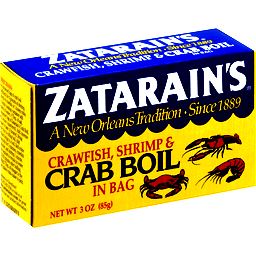
Old Bay Seasoning for crab or shrimp boil is probably the nationwide favorite, but Zatarain’s would definitely get my vote. Not only is it my go-to for cooking boiled shrimp, but I use it in dips, and I add a little to my gumbo.
Zatarain’s, another New Orleans-based company, has a whole line of foods, but their crab boil and creole mustard are the best in their category for a lot of us. Creole mustard uses Dijon-style mustard as a base, with Worcestershire sauce and hot sauce added for spice, and ground mustard seeds. Grey Poupon makes a country Dijon mustard that’s a worthy substitute. Still, it would be a crying shame to use anything but a New Orleans-made product on a po’boy or in a creole remoulade sauce. Wouldn’t it?
Here’s an excellent place to put Zatarain’s Creole Mustard:
EMARIL LAGASSE’S CREOLE REMOULADE SAUCE
INGREDIENTS
DIRECTIONS
It’s doubtful that the info here will change any minds about their preferred condiments, but that really wasn’t my intention. I just needed a topic for an article. But, this is making me hungry for a shrimp po’boy, which would incorporate the hot sauce, the mayo, the shrimp boil, AND the creole mustard—of my choice!
Photos: Deborah Fagan Carpenter

“The boat ride to Yamacraw became a celebration of sorts. It was a time when I became aware of tides ebbing and flooding in accordance with the transcendental clockwork of the universe; a time of the pale, wafer-thin moon in the early morning sky and of the last star to vanish with the coming of the sun over green waters.”
—Pat Conroy, The Water is Wide
Painting: Deborah Fagan Carpenter

“I am an old Southern woman, and I’m supposed to wear funny clothes, ugly hats, and dig in the dirt.
I did not make the rules.”
— Ouiser Boudreaux,
Steel Magnolias
Photo: Deborah Fagan Carpenter

“Our lives begin to end the day we become silent about things that matter.”
— Martin Luther King, Jr.
Photo: Deborah Fagan Carpenter

“Comely was the town by the curving river that they dismantled in a year’s time. Beautiful was Colleton in her last spring as she flung azaleas like a girl throwing rice at a desperate wedding. In dazzling profusion, Colleton ripened in a gauze of sweet gardens and the town ached beneath a canopy of promissory fragrance.”
— Pat Conroy, The Prince of Tides
Photo: Deborah Fagan Carpenter

“April that year came sudden and still, and the green of the trees was a wild bright green. The pale wisterias bloomed all over town, and silently the blossoms shattered.”
— Carson McCullers,
The Member of the Wedding
Photo: Deborah Fagan Carpenter
Creamy Chicken Salad
By Patsy R. Brumfield
The Southfacin’ Cook

Springtime means Chicken Salad time with thoughts of croissant sandwiches or topping crisp lettuce to enjoy outside on the back deck with a tall, cool glass of iced tea – lemon wedge, please. Some years ago, TV celebrity chef Ina Gartin brought me back to Chicken Salad, especially the part about making the sauce first, then adding the baked chicken still warm to absorb it. Gotta say, A-1, Ina.

So, here’s the way I do it, including a “secret” ingredient revealed by my longtime friend, journalist Leslie Criss of Tupelo. Thanks to both ladies for helping me bring it to you. Enjoy.
EQUIPMENT: Mixing bowls, smaller bowls for chopped ingredients, chef’s knife, measuring gear, chopping board, baking sheet, whisk, rubber spatula, parchment paper, paper towel
INGREDIENTS
2 large boneless, skinless chicken breasts
Olive oil
Kosher salt
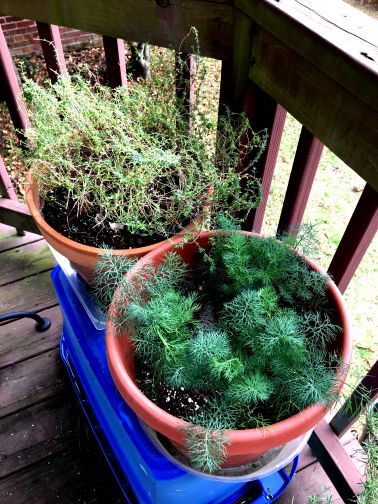
Sauce:
½ cup Duke’s mayonnaise
½ cup whole-milk yogurt
1 Tablespoon yellow mustard
1 teaspoon mild curry powder
Zest of one lemon
Juice of ½ lemon
Handful of fresh dill, rough-chopped
4 celery stalks, small diced
4-6 green onions, sliced
24 red or green seedless grapes
Salt and pepper to taste
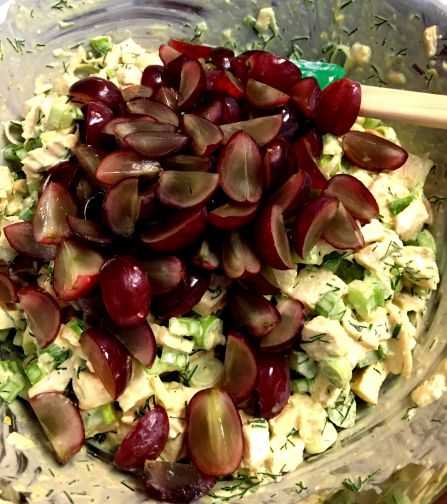
Let’s get started
Wash thoroughly celery, green onions and grapes. Rinse dill and shake dry. Rinse and dry lemon.
1. Heat oven to 375. Cover medium baking sheet with parchment paper. Rinse chicken breasts and place on baking sheet. Dry top with paper towel. Lightly sprinkle olive oil and Kosher salt. Bake 45 minutes until breasts reach 160 degrees. Remove from the oven and allow about 15 minutes to cool enough to handle.
2. While chicken bakes, prep and measure all other ingredients.
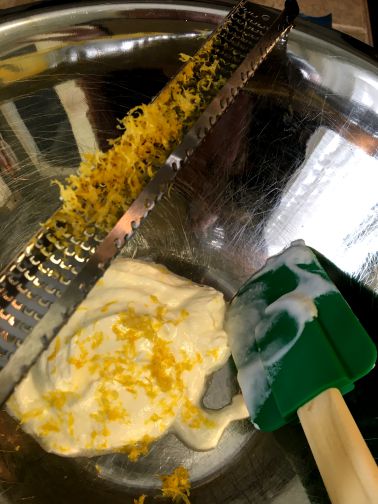
3. In a large mixing bowl, prepare the sauce: combine mayo, yogurt, mustard, curry powder, lemon zest, lemon juice, dill, pepper. Whisk well. When chicken has cooled enough to handle, dice or shred into small pieces (1/4-inch or so) and add chicken bits to sauce. Combine well.
4. Then add diced celery and green onion slices. Combine well and taste for salt and pepper. Add more, if necessary.
5. Quarter each grape long-wise and with the rubber spatula fold into the ready chicken mixture. Cover with plastic wrap and refrigerate at least an hour to allow ingredients to meld.
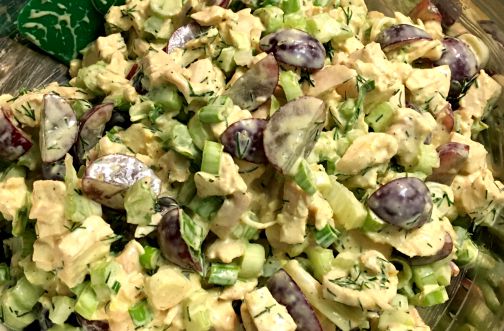
NOTE: I believe you can feed at least 4-6 people with this recipe. It works well when you need to double etc. for a crowd.
Photos: Patsy R. Brumfield